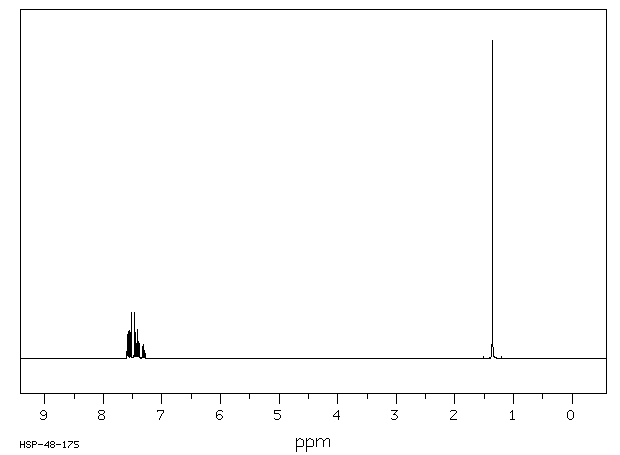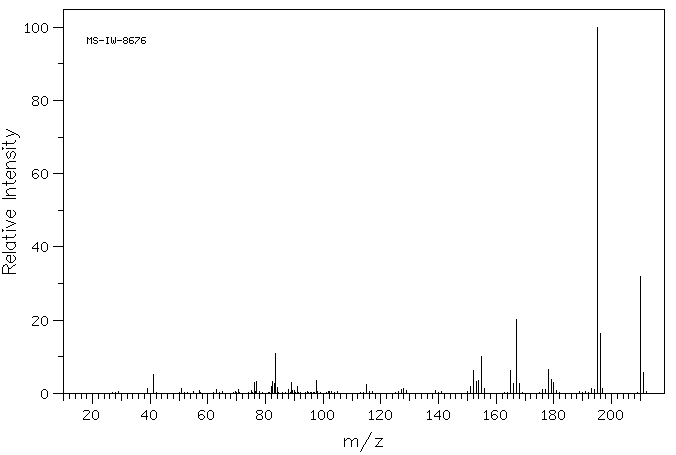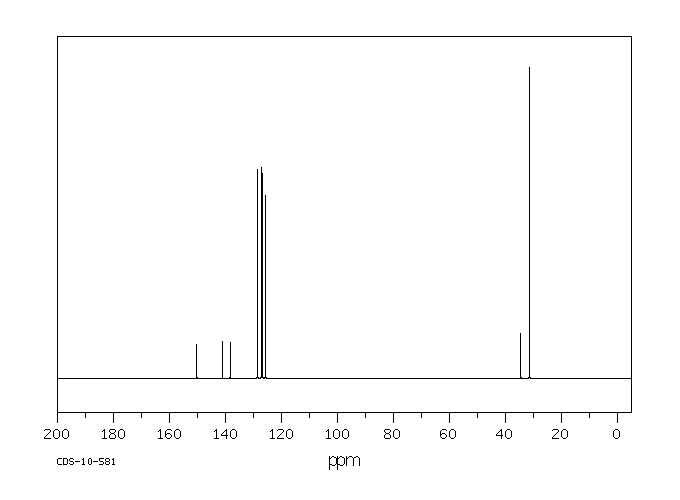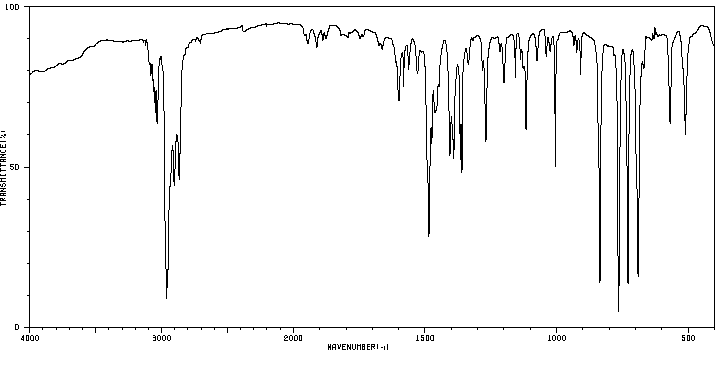4-叔丁基联苯 | 1625-92-9
中文名称
4-叔丁基联苯
中文别名
一缩二乙二醇一(2-乙基已基)醚;二甘醇(2-乙己基)醚;2-乙己基卡必醇;二甘醇一(2-乙己基)醚;一缩二乙二醇单(2-乙基已基)醚;二乙二醇单辛醚;对叔丁基联苯;4,4'-双叔丁基联苯;2-{(2-[(2-乙基己基)氧基]乙氧基}乙醇;二甘醇单(2-乙己基)醚
英文名称
4-tert-butylbiphenyl
英文别名
4-(tert-butyl)-1,1'-biphenyl;4-(tert-butyl)-1,1′-biphenyl;4-t-butylbiphenyl;4-phenyl-1-tert-butylbenzene;1-tert-butyl-4-phenylbenzene
CAS
1625-92-9
化学式
C16H18
mdl
MFCD00222366
分子量
210.319
InChiKey
CDOYZTOFTGTGBC-UHFFFAOYSA-N
BEILSTEIN
——
EINECS
——
-
物化性质
-
计算性质
-
ADMET
-
安全信息
-
SDS
-
制备方法与用途
-
上下游信息
-
文献信息
-
表征谱图
-
同类化合物
-
相关功能分类
-
相关结构分类
物化性质
-
熔点:52 °C
-
沸点:310 °C
-
密度:1.03 g/cm3(Temp: 25.00 °C)
计算性质
-
辛醇/水分配系数(LogP):5.9
-
重原子数:16
-
可旋转键数:2
-
环数:2.0
-
sp3杂化的碳原子比例:0.25
-
拓扑面积:0
-
氢给体数:0
-
氢受体数:0
安全信息
-
危险品标志:Xi
-
海关编码:2902909090
-
储存条件:室温且干燥
SDS
Section I.Chemical Product and Company Identification
Chemical Name 4-tert-Butylbiphenyl
Portland OR
Synonym Not available.
Chemical Formula C16H18
CAS Number 1625-92-9
Section II. Composition and Information on Ingredients
Chemical Name CAS Number Percent (%) TLV/PEL Toxicology Data
4-tert-Butylbiphenyl 1625-92-9 Min. 98.0 Not available. Not available.
(GC)
Section III. Hazards Identification
Acute Health Effects No specific information is available in our data base regarding the toxic effects of this material for humans. However,
exposure to any chemical should be kept to a minimum. Skin and eye contact may result in irritation. May be harmful if
inhaled or ingested. Always follow safe industrial hygiene practices and wear proper protective equipment when handling
this compound.
CARCINOGENIC EFFECTS : Not available.
Chronic Health Effects
MUTAGENIC EFFECTS : Not available.
TERATOGENIC EFFECTS : Not available.
DEVELOPMENTAL TOXICITY: Not available.
There is no known effect from chronic exposure to this product. Repeated or prolonged exposure to this compound is
not known to aggravate existing medical conditions.
Section IV. First Aid Measures
Eye Contact Check for and remove any contact lenses. DO NOT use an eye ointment. Flush eyes with running water for a minimum
of 15 minutes, occasionally lifting the upper and lower eyelids. Seek medical attention. Treat symptomatically and
supportively.
Skin Contact If the chemical gets spilled on a clothed portion of the body, remove the contaminated clothes as quickly as possible,
protecting your own hands and body. Place the victim under a deluge shower. If the chemical touches the victim's
exposed skin, such as the hands: Gently and thoroughly wash the contaminated skin with running water and non-abrasive
soap. Be particularly careful to clean folds, crevices, creases and groin. Cover the irritated skin with an emollient. Seek
medical attention. Treat symptomatically and supportively. Wash any contaminated clothing before reusing.
Inhalation If the victim is not breathing, perform artificial respiration. Loosen tight clothing such as a collar, tie, belt or waistband. If
breathing is difficult, oxygen can be administered. Seek medical attention. Treat symptomatically and supportively.
Ingestion INDUCE VOMITING by sticking finger in throat. Lower the head so that the vomit will not reenter the mouth and throat.
Loosen tight clothing such as a collar, tie, belt, or waistband. If the victim is not breathing, administer artificial respiration.
Examine the lips and mouth to ascertain whether the tissues are damaged, a possible indication that the toxic material
was ingested; the absence of such signs, however, is not conclusive. Seek immediate medical attention and, if possible,
show the chemical label. Treat symptomatically and supportively.
Section V. Fire and Explosion Data
Auto-Ignition Not available.
Flammability Combustible.
Flash Points Flammable Limits Not available.
Not available.
Combustion Products These products are toxic carbon oxides (CO, CO 2).
Fire Hazards
No specific information is available regarding the flammability of this compound in the presence of various materials.
Explosion Hazards Risks of explosion of the product in presence of mechanical impact: Not available.
Risks of explosion of the product in presence of static discharge: Not available.
No additional information is available regarding the risks of explosion.
Fire Fighting Media
SMALL FIRE: Use DRY chemicals, CO 2, water spray or foam.
and Instructions LARGE FIRE: Use water spray, fog or foam. DO NOT use water jet.
Continued on Next Page
4-tert-Butylbiphenyl
Section VI. Accidental Release Measures
Spill Cleanup In case of a spill and/or a leak, always shut off any sources of ignition, ventilate the area, and exercise caution. Use a
Instructions shovel to put the material into a convenient waste disposal container. Finish cleaning the spill by rinsing any
contaminated surfaces with copious amounts of water. Consult federal, state, and/or local authorities for assistance on
disposal.
Section VII. Handling and Storage
Handling and Storage Keep away from heat and sources of ignition. Mechanical exhaust required. When not in use, tightly seal the container
and store in a dry, cool place. Avoid excessive heat and light. DO NOT breathe dust. In case of insufficient ventilation,
Information
wear suitable respiratory equipment. If you feel unwell, seek medical attention and show the label when possible. Treat
symptomatically and supportively. Avoid contact with skin and eyes.
Always store away from incompatible compounds such as oxidizing agents.
Section VIII. Exposure Controls/Personal Protection
Engineering Controls Use process enclosures, local exhaust ventilation, or other engineering controls to keep airborne levels below
recommended exposure limits. If user operations generate dust, fume or mist, use ventilation to keep exposure to
airborne contaminants below the exposure limit.
Personal Protection Splash goggles. Lab coat. Dust respirator. Boots. Gloves. A MSHA/NIOSH approved respirator must be used to avoid
inhalation of the product. Suggested protective clothing might not be sufficient; consult a specialist BEFORE handling
this product.
Exposure Limits Not available.
Section IX. Physical and Chemical Properties
Physical state @ 20°C Solid. Solubility
Not available.
Not available.
Specific Gravity
Molecular Weight 210.32 Partition Coefficient
Not available.
Boiling Point Not available. Vapor Pressure Not available.
Melting Point 52°C (125.6°F) Vapor Density Not available.
Not available. Not available.
Refractive Index Volatility
Critical Temperature Not available. Odor Not available.
Viscosity Not available. Taste Not available.
Section X. Stability and Reactivity Data
Stability
This material is stable if stored under proper conditions. (See Section VII for instructions)
Conditions of Instability
Avoid excessive heat and light.
Incompatibilities
Reactive with oxidizing agents.
Section XI. Toxicological Information
RTECS Number Not available.
Routes of Exposure Eye contact. Inhalation. Ingestion.
Not available.
Toxicity Data
CARCINOGENIC EFFECTS : Not available.
Chronic Toxic Effects
MUTAGENIC EFFECTS : Not available.
TERATOGENIC EFFECTS : Not available.
DEVELOPMENTAL TOXICITY: Not available.
There is no known effect from chronic exposure to this product. Repeated or prolonged exposure to this compound is not
known to aggravate existing medical conditions.
Acute Toxic Effects No specific information is available in our data base regarding the toxic effects of this material for humans. However,
exposure to any chemical should be kept to a minimum. Skin and eye contact may result in irritation. May be harmful if
inhaled or ingested. Always follow safe industrial hygiene practices and wear proper protective equipment when handling
this compound.
Continued on Next Page
4-tert-Butylbiphenyl
Section XII. Ecological Information
Ecotoxicity Not available.
Environmental Fate Not available.
Section XIII. Disposal Considerations
Recycle to process, if possible. Consult your local or regional authorities. You may be able to dissolve or mix material with
Waste Disposal
a combustible solvent and burn in a chemical incinerator equipped with an afterburner and scrubber system. Observe all
federal, state, and local regulations when disposing of this substance.
Section XIV. Transport Information
DOT Classification Not a DOT controlled material (United States).
PIN Number Not applicable.
Proper Shipping Name
Not applicable.
Packing Group (PG) Not applicable.
DOT Pictograms
Section XV. Other Regulatory Information and Pictograms
TSCA Chemical Inventory This product is NOT on the EPA Toxic Substances Control Act (TSCA) inventory. The following notices are required by 40
CFR 720.36 (C) for those products not on the inventory list:
(EPA)
(i) These products are supplied solely for use in research and development by or under the supervision of a technically
qualified individual as defined in 40 CFR 720.0 et sec.
(ii) The health risks of these products have not been fully determined. Any information that is or becomes available will be
supplied on an MSDS sheet.
WHMIS Classification Not controlled under WHMIS (Canada).
(Canada)
EINECS Number (EEC) Not available.
EEC Risk Statements Not available.
SECTION 16 - ADDITIONAL INFORMATION
N/A
制备方法与用途
金属有机框架(MOFs)和原材料
上下游信息
-
上游原料
中文名称 英文名称 CAS号 化学式 分子量 4-叔丁基-4'-氨基联苯 4-Amino-4'-tert-butyl-biphenyl 5728-71-2 C16H19N 225.334 4-溴-4'-叔丁基联苯 4-bromo-4'-tert-butylbiphenyl 162258-89-1 C16H17Br 289.215 —— 1-p-biphenylyl-2-chloro-2-methylpropane 81770-12-9 C16H17Cl 244.764 叔丁基苯 tert-butylbenzene 98-06-6 C10H14 134.221 4-三氟甲基联苯 1-phenyl-4-(trifluoromethyl)benzene 398-36-7 C13H9F3 222.21 -
下游产品
中文名称 英文名称 CAS号 化学式 分子量 4-异丙基联苯 4-isopropylbiphenyl 7116-95-2 C15H16 196.292 —— 4-(tert-butyl)-4'-iodo-1,1'-biphenyl —— C16H17I 336.215 4-乙基联苯 4-ethylbiphenyl 5707-44-8 C14H14 182.265 4-正丙基联苯 4-propyl-1,1'-biphenyl 10289-45-9 C15H16 196.292 4-(4-叔丁基苯基)苯甲酸 4'-tert.-Butyl-biphenyl-4-carbonsaeure 5748-42-5 C17H18O2 254.329 4-丁基联苯 4-butylbiphenyl 37909-95-8 C16H18 210.319 1-叔丁基-3-苯基苯 3-tert-butylbiphenyl 2113-60-2 C16H18 210.319 4-甲基联苯 4-Methylbiphenyl 644-08-6 C13H12 168.238
反应信息
-
作为反应物:描述:参考文献:名称:烷基联苯异构转化的平衡摘要:摘要 研究了液相中单、二和三烷基联苯 ( abp ) 相互转化的平衡,温度为 308 至 423 K。根据实验平衡常数,ΔrHmo/(kJ·mol−1) 值和ΔrSmo/(J·K-1·mol-1)被计算。下面分别给出:Et-bp (I)、i-Pr-bp (II) 和 t-Bu-bp (III) 的反应、化合物和值: 4- abp = 3- abp , I, 0.23, 5.76 ; 二、(0.45±0.41)、(5.72±1.13);三、(0.48±0.53)、(4.83±0.53);2- abp = 4- abp , I, -3.3, -5.76; II、-12.6、-5.76;III、-15.4、-5.76;3,5-di-abp = 3,3'-di-abp, I, -0.1, 5.76; 二、(0±0.60)、(5.98±1.65);三、(-1.34±0.67)、(4.48±1.87);3DOI:10.1016/0021-9614(87)90137-6
-
作为产物:描述:2,2,2-三甲基苯乙酮 在 吡啶 、 tris-(dibenzylideneacetone)dipalladium(0) 、 盐酸羟胺 、 sodium acetate 、 C13H18N2O2 、 potassium carbonate 作用下, 以 乙醇 、 二氯甲烷 、 1,2-二氯乙烷 为溶剂, 反应 48.0h, 生成 4-叔丁基联苯参考文献:名称:芳基酮作为钯催化的 Suzuki-Miyaura 联轴器中的芳基供体摘要:在此,我们报告了通过钯催化的 Suzuki-Miyaura 交叉偶联反应对芳基酮进行的芳基化、烷基化和烯基化。吡啶-恶唑啉配体的使用是断裂无应变 C-C 键的关键。源自药物和天然产物的芳基酮的后期芳基化证明了该协议的合成效用。DOI:10.1021/acs.orglett.1c03048
文献信息
-
Cross-Coupling of Triallyl(aryl)silanes with Aryl Bromides and Chlorides: An Alternative Convenient Biaryl Synthesis作者:Akhila K. Sahoo、Takuro Oda、Yoshiaki Nakao、Tamejiro HiyamaDOI:10.1002/adsc.200404188日期:2004.12give various biaryls in good yields. It is worthwhile to note that the all-carbon-substituted arylsilanes, stable towards moisture, acid, and base and easily accessible, serve as a highly practical alternative to their aryl(halo)silane counterparts. A catalyst system consisting of [(η3-C3H5)PdCl]2 and 2-[2,4,6-(i-Pr)3C6H2]-C6H4PCy2 and use of TBAF⋅3 H2O in THF-H2O are effective especially for the cross-coupling在DMSO-H 2 O中存在PdCl 2 / PCy 3和氟化四丁基铵(TBAF)的情况下,多种芳基溴化物与三烯丙基(芳基)硅烷的交叉偶联是有效的,以高收率得到各种联芳基。值得一提的是,全碳取代的芳基硅烷对水分,酸和碱稳定,易于获得,可作为其芳基(卤代)硅烷对应物的高度实用替代品。由[(η的催化剂体系3 -C 3 H ^ 5)的PdCl] 2和2- [2,4,6-(我-Pr)3 c ^ 6 ħ 2 ] -C 6 H ^ 4 PCY2和在THF-H 2 O中使用TBAF·3 H 2 O对于与芳基氯的交叉偶联特别有效。两种催化剂体系均能耐受多种常见的官能团。推测反应的高效率归因于用TBAF·3 H 2 O和适量的水处理后烯丙基的易裂解。二烯丙基(二苯基)硅烷还可以与各种芳基溴化物和氯化物交联,收率很高,而烯丙基(三苯基)硅烷只能以中等收率得到交联产物。通过溴氯苯与不同芳基硅烷的顺序交叉偶联,可
-
Metal-free oxidative decarbonylative coupling of aromatic aldehydes with arenes: direct access to biaryls作者:Ren-Jin Tang、Qing He、Luo YangDOI:10.1039/c4cc10155c日期:——A metal-free oxidative decarbonylative coupling of aromatic aldehydes with electron-rich or electron-deficient arenes to produce biaryl compounds was developed. This novel coupling was proposed to proceed via a non-chain radical homolytic aromatic substitution (HAS) type mechanism, based on the substrate scope, ortho-regioselectivity, radical trapping experiments and DFT calculation studies. With the
-
Cobalt‐Catalyzed Direct Arylation of Unactivated Arenes with Aryl Halides作者:Wei Liu、Hao Cao、Jie Xin、Liqun Jin、Aiwen LeiDOI:10.1002/chem.201002290日期:2011.3.21and simple: The direct arylation of unactivated arenes with aryl halides has been carried out with [Co(acac)3] as the catalyst and LiHMDS as the base. The corresponding biaryl compounds have been prepared in good to excellent yields and at a relatively low reaction temperature (see scheme; acac=acetylacetonate, LiHMDS=lithium bis(trimethylsilyl)amide). An intramolecular direct arylation has also been
-
Tandem CH Activation/Arylation Catalyzed by Low-Valent Iron Complexes with Bisiminopyridine Ligands作者:Elise Salanouve、Ghania Bouzemame、Sébastien Blanchard、Etienne Derat、Marine Desage-El Murr、Louis FensterbankDOI:10.1002/chem.201304459日期:2014.4.14Tandem CH activation/arylation between unactivated arenes and aryl halides catalyzed by iron complexes that bear redox‐active non‐innocent bisiminopyridine ligands is reported. Similar reactions catalyzed by first‐row transition metals have been shown to involve substrate‐based aryl radicals, whereas our catalytic system likely involves ligand‐centered radicals. Preliminary mechanistic investigations
-
Green Synthesis of Palladium Nanoparticles: Applications in Aryl Halide Cyanation and Hiyama Cross-Coupling Reaction Under Ligand Free Conditions作者:Vishal Kandathil、Ramesh B. Dateer、B. S. Sasidhar、Shivaputra A. Patil、Siddappa A. PatilDOI:10.1007/s10562-018-2369-5日期:2018.6in aryl halide cyanation and Hiyama cross-coupling reactions. Also, less toxic potassium hexacyanoferrate(II) trihydrate was used as cyanide source in aryl halide cyanation and Hiyama cross-coupling was performed under fluoride free condition. Both reactions proceeded well with Pd NPs under ligand free circumstances to give good to excellent yields. The Pd NPs were recovered after each reaction and摘要在目前的工作中,使用黑胡椒(Piper nigrum)的水乙醇提取物从醋酸钯生物源制备钯纳米颗粒(Pd NPs),并通过各种分析技术,如 XRD、FE-SEM、EDS、TEM、ATR-IR 进行表征。 、UV-Vis 光谱、BET、TGA 和 ICP-OES 分析。将 Pd(II) 还原为 Pd(0) 是通过黑胡椒提取物中存在的各种植物化学物质的作用实现的,例如酚类、酸类、胡椒碱、胡椒基氰基乙酸乙酯、胡椒碱和 N-异丁基-十四烷-2,4-二烯酰胺. 生物合成的 Pd NPs 在芳基卤氰化和 Hiyama 交叉偶联反应中显示出优异的催化活性。此外,毒性较小的六氰基高铁酸钾 (II) 三水合物用作芳基卤氰化中的氰化物源,并且在无氟条件下进行 Hiyama 交叉偶联。在无配体的情况下,Pd NPs 的两个反应都进行得很好,以提供良好的收率。每次反应后 Pd NPs 被回收,并在芳基卤化氰化中循环最多
表征谱图
-
氢谱1HNMR
-
质谱MS
-
碳谱13CNMR
-
红外IR
-
拉曼Raman
-
峰位数据
-
峰位匹配
-
表征信息
同类化合物
(βS)-β-氨基-4-(4-羟基苯氧基)-3,5-二碘苯甲丙醇
(S,S)-邻甲苯基-DIPAMP
(S)-(-)-7'-〔4(S)-(苄基)恶唑-2-基]-7-二(3,5-二-叔丁基苯基)膦基-2,2',3,3'-四氢-1,1-螺二氢茚
(S)-盐酸沙丁胺醇
(S)-3-(叔丁基)-4-(2,6-二甲氧基苯基)-2,3-二氢苯并[d][1,3]氧磷杂环戊二烯
(S)-2,2'-双[双(3,5-三氟甲基苯基)膦基]-4,4',6,6'-四甲氧基联苯
(S)-1-[3,5-双(三氟甲基)苯基]-3-[1-(二甲基氨基)-3-甲基丁烷-2-基]硫脲
(R)富马酸托特罗定
(R)-(-)-盐酸尼古地平
(R)-(-)-4,12-双(二苯基膦基)[2.2]对环芳烷(1,5环辛二烯)铑(I)四氟硼酸盐
(R)-(+)-7-双(3,5-二叔丁基苯基)膦基7''-[((6-甲基吡啶-2-基甲基)氨基]-2,2'',3,3''-四氢-1,1''-螺双茚满
(R)-(+)-7-双(3,5-二叔丁基苯基)膦基7''-[(4-叔丁基吡啶-2-基甲基)氨基]-2,2'',3,3''-四氢-1,1''-螺双茚满
(R)-(+)-7-双(3,5-二叔丁基苯基)膦基7''-[(3-甲基吡啶-2-基甲基)氨基]-2,2'',3,3''-四氢-1,1''-螺双茚满
(R)-(+)-4,7-双(3,5-二-叔丁基苯基)膦基-7“-[(吡啶-2-基甲基)氨基]-2,2”,3,3'-四氢1,1'-螺二茚满
(R)-3-(叔丁基)-4-(2,6-二苯氧基苯基)-2,3-二氢苯并[d][1,3]氧杂磷杂环戊烯
(R)-2-[((二苯基膦基)甲基]吡咯烷
(R)-1-[3,5-双(三氟甲基)苯基]-3-[1-(二甲基氨基)-3-甲基丁烷-2-基]硫脲
(N-(4-甲氧基苯基)-N-甲基-3-(1-哌啶基)丙-2-烯酰胺)
(5-溴-2-羟基苯基)-4-氯苯甲酮
(5-溴-2-氯苯基)(4-羟基苯基)甲酮
(5-氧代-3-苯基-2,5-二氢-1,2,3,4-oxatriazol-3-鎓)
(4S,5R)-4-甲基-5-苯基-1,2,3-氧代噻唑烷-2,2-二氧化物-3-羧酸叔丁酯
(4S,4''S)-2,2''-亚环戊基双[4,5-二氢-4-(苯甲基)恶唑]
(4-溴苯基)-[2-氟-4-[6-[甲基(丙-2-烯基)氨基]己氧基]苯基]甲酮
(4-丁氧基苯甲基)三苯基溴化磷
(3aR,8aR)-(-)-4,4,8,8-四(3,5-二甲基苯基)四氢-2,2-二甲基-6-苯基-1,3-二氧戊环[4,5-e]二恶唑磷
(3aR,6aS)-5-氧代六氢环戊基[c]吡咯-2(1H)-羧酸酯
(2Z)-3-[[(4-氯苯基)氨基]-2-氰基丙烯酸乙酯
(2S,3S,5S)-5-(叔丁氧基甲酰氨基)-2-(N-5-噻唑基-甲氧羰基)氨基-1,6-二苯基-3-羟基己烷
(2S,2''S,3S,3''S)-3,3''-二叔丁基-4,4''-双(2,6-二甲氧基苯基)-2,2'',3,3''-四氢-2,2''-联苯并[d][1,3]氧杂磷杂戊环
(2S)-(-)-2-{[[[[3,5-双(氟代甲基)苯基]氨基]硫代甲基]氨基}-N-(二苯基甲基)-N,3,3-三甲基丁酰胺
(2S)-2-[[[[[((1S,2S)-2-氨基环己基]氨基]硫代甲基]氨基]-N-(二苯甲基)-N,3,3-三甲基丁酰胺
(2S)-2-[[[[[[((1R,2R)-2-氨基环己基]氨基]硫代甲基]氨基]-N-(二苯甲基)-N,3,3-三甲基丁酰胺
(2-硝基苯基)磷酸三酰胺
(2,6-二氯苯基)乙酰氯
(2,3-二甲氧基-5-甲基苯基)硼酸
(1S,2S,3S,5S)-5-叠氮基-3-(苯基甲氧基)-2-[(苯基甲氧基)甲基]环戊醇
(1S,2S,3R,5R)-2-(苄氧基)甲基-6-氧杂双环[3.1.0]己-3-醇
(1-(4-氟苯基)环丙基)甲胺盐酸盐
(1-(3-溴苯基)环丁基)甲胺盐酸盐
(1-(2-氯苯基)环丁基)甲胺盐酸盐
(1-(2-氟苯基)环丙基)甲胺盐酸盐
(1-(2,6-二氟苯基)环丙基)甲胺盐酸盐
(-)-去甲基西布曲明
龙蒿油
龙胆酸钠
龙胆酸叔丁酯
龙胆酸
龙胆紫-d6
龙胆紫










